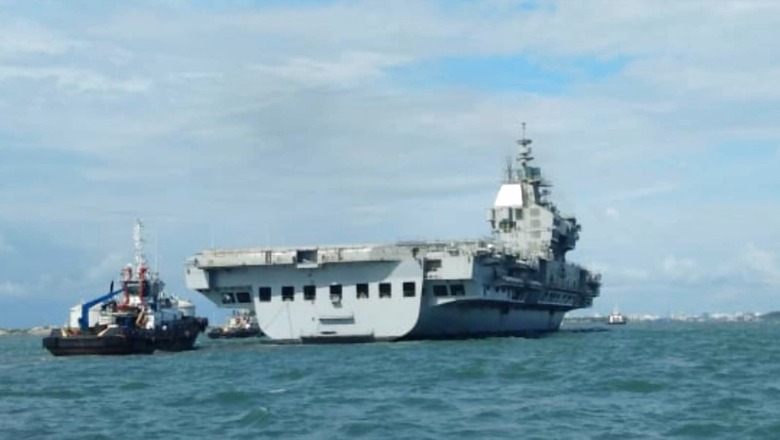
views
In the past two decades, the Chinese People’s Liberation Army Navy (PLA Navy, or PLAN) has more than trebled in size. In 2020, when the PLAN overtook the US Navy (USN) to become the largest Navy in the world by number of commissioned warships, some commentators pointed out that the US still held the lead in tonnage afloat, particularly when it came to the most potent ship classes—aircraft carriers, cruisers, and destroyers. Other analyses pointed out that the US benefits from allied and friendly navies in the Indo-Pacific region. This latter line of reasoning has been borne out to an extent by the recent Australia-UK-USA (AUKUS) security pact.
Regardless, China has worked concertedly toward addressing military imbalances vis-à-vis the US, and these efforts have borne fruit. Sweeping reforms to an outdated military saddled with too much manpower have allowed China to allocate resources to the capital- and technology-intensive maritime and aerial domains. The 2019 Defence White Paper made clear reference to significant downsizing of the PLA Army in favour of the PLA Air Force (PLAAF), PLAN and PLA Rocket Force (PLARF). In April 2021, the PLAN commissioned three new warships together on the same day. Crucially, these were not small inshore vessels, but an amphibious assault ship, a guided missile cruiser, and a nuclear-powered ballistic missile submarine—exactly the types of ships that analysts have said the PLAN lacks as it squares up the US Navy.
China’s focus on matching the US military in the Indo-Pacific has a mixed impact on India. On the one hand, particularly in the maritime domain, even with a growing force of destroyers, cruisers and aircraft carriers, China will have to dedicate almost all its naval resources to the Western Pacific to be able to viably counter the US and its allied navies. The centrality of nuclear-powered submarines to the new AUKUS grouping only increases the attention China will have to pay to the waters east of Malacca. This means the Indian Navy should have some breathing room before the PLAN outgrows home waters and establishes a more permanent presence in the Indian Ocean Region (IOR), long considered India’s maritime ‘backyard’.
On the other hand, reorienting and expanding to address the US Navy means that the PLAN is already far larger than the Indian Navy, and still growing at a faster pace. In a near-term contingency, Beijing could bring a disproportionate maritime capability to bear on the IOR. With an explicitly military base in Djibouti, and access to a large number of Belt and Road Initiative (BRI) ports, the logistical burdens of conducting operations in the IOR will be greatly mitigated. It is worth noting that China already operates some 15 frontline replenishment ships and with the Y-20 strategic airlifter in service in rapidly increasing numbers, the PLAN’s ability to conduct out-of-area operations is no longer as limited as it once was.
ALSO READ | AUKUS or Not, Why France is India’s Preferred Partner for Nuclear Attack Submarines
India’s Options at Sea
Most major military powers—including China—have downsized military manpower in favour of technology. Even countries facing active conflict, with border problems no less intractable than India’s, such as South Korea and Israel, have moved past land-centric military postures. Indian military thought, however, remains landlocked, to the detriment of its maritime and air power. This is most visible in funding, where even as defence spending shrinks relative to central government expenditure, the Army still accounts for the lion’s share.
In the near term, India’s options at sea are simple—to privilege sea denial strategies, even in the IOR. To be clear, India already exercises ‘sea control’ over its home waters, indeed most of the IOR, even in the face of capability gaps such as helicopters and submarines. But in pure capability terms, the need of the hour is more numerous, heavily armed, and above all, cheap and quick-to-build surface vessels, particularly in the face of the Navy’s seemingly intractable submarine woes. An ocean teeming with such warships will do more to keep the PLAN at bay than any number of ambitious projects that will still be stuck in shipyards while the Chinese commission capital ships by the dozen. If the Indian Navy can commission one missile boat or corvette for every Chinese destroyer, it will be enough to upend any designs Beijing might have for the IOR.
Warship production at scale is something India has never been able to achieve. Long gestation periods and slow build rates mean the Navy is forced to move to new designs after commissioning only a handful of ships of each class. This in turn puts added pressure on the already miniscule capital budget. A small but capable ship class would also allow for some decompression of the Navy’s budget, provide a regular and predictable run of work to domestic shipbuilding industries, and might finally result in an exportable warship that could begin to recoup some of its costs.
In the long term, beyond getting back into operational and platform specifics, or even budgetary allocation, the most important change will be to increase the Navy’s purchasing power. The only way to do this is to move procurement in-country—and building up a strong industrial base will allow this to happen naturally. This is as true for the Navy as it is for the other services. Assuming India will not be able to resolve its military manpower issues, nor the spending skew toward the Army, there is little choice but to produce as much capital equipment as possible domestically. A rupee spent at home will buy more than a dollar or euro or ruble spent abroad—to say nothing of the indirect effects of increased domestic spending. In the past, building military capability alongside national capacity was seen as a self-contradictory endeavour. While it is true that in traditional planning and operating paradigms, the two compete directly for resources, there is no reason for that to be the case indefinitely.
This article was first published on ORF.
The author is a Project Coordinator with ORF’s Strategic Studies Programme. The views expressed in this article are those of the author and do not represent the stand of this publication.
Read all the Latest News , Breaking News and IPL 2022 Live Updates here.




















Comments
0 comment